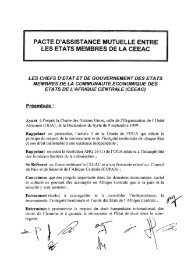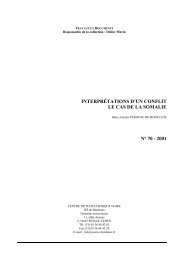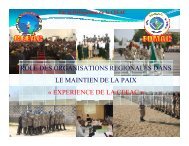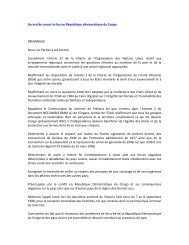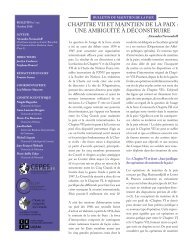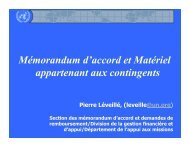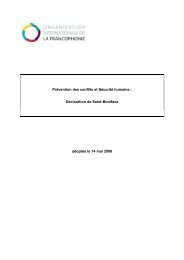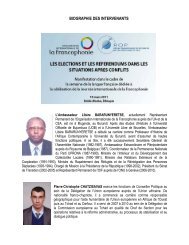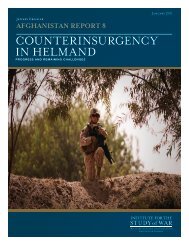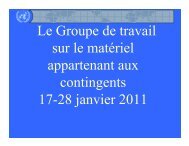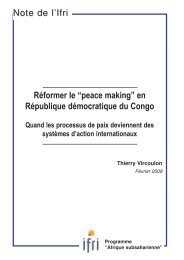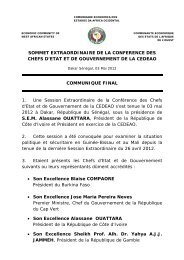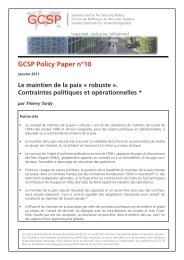engaging fragile states - Woodrow Wilson International Center for ...
engaging fragile states - Woodrow Wilson International Center for ...
engaging fragile states - Woodrow Wilson International Center for ...
Create successful ePaper yourself
Turn your PDF publications into a flip-book with our unique Google optimized e-Paper software.
sophisticated tool that is expected to manage responses to crisis situations, but it<br />
has yet to be put into practice.<br />
The second main obstacle is the imbalance of resources between DOD and<br />
civilian agencies. The military has been seeking civilian partnerships to help plan<br />
engagement strategies <strong>for</strong> stabilization operations, but these ef<strong>for</strong>ts have been<br />
limited due to the severe resource constraints of civilian agencies. Consequently,<br />
in order to support Department of State programs in security, reconstruction or<br />
stabilization, Section 1207 of the FY 2006 National Defense Authorization Act<br />
authorized the Secretary of Defense to support the transfer of up to $100 million<br />
per year <strong>for</strong> two years <strong>for</strong> these purposes. It was renewed <strong>for</strong> an additional<br />
$100 million in 2008. Until Congress recognizes that different legal and funding<br />
mechanisms are a necessity <strong>for</strong> civilian capacities to have a robust enough capability<br />
to engage in failed and <strong>fragile</strong> <strong>states</strong>, the advancement of US national interests<br />
will continue to be hindered. Though progress is being made, Congress and its<br />
committee structures continue to affect the development of S/CRS, which has<br />
suffered from anemic financing. It was not until fiscal year 2009 that $250 million<br />
were proposed to expand the CRC and create the reserve unit. Through two<br />
supplemental appropriations, Congress has only provided about half that amount.<br />
The only project money <strong>for</strong> S/CRS during this time came from the DOD of about<br />
$100 million per year via the “1207” funds. In the view of many, Congress still<br />
brings a Cold War mentality to matters of how the United States should approach<br />
national security. Thus, Congress has not recognized that dramatically increasing<br />
funding to USAID is possibly as relevant to protecting US security interests as<br />
is promoting missile defense or building additional aircraft carrier battle groups.<br />
This outlook needs to change if the US executive architecture is going to be restructured<br />
to make its civilian agencies equivalent partners with the assets and<br />
resources of the DOD.<br />
A related problem is the continued tendency to militarize US <strong>for</strong>eign policy.<br />
In recent history, the number of successful US stabilization and reconstruction<br />
operations has been relatively weak, most often when the responsibility of <strong>for</strong>mulating<br />
them lies heavily in hands of US military <strong>for</strong>ces. During the Bush administration,<br />
the State Department developed a blueprint <strong>for</strong> reconstruction in<br />
Iraq that was intended <strong>for</strong> use after the invasion. Even though it was never used,<br />
the conceptual framework that the blueprint stemmed from provides insight into<br />
the perspective of many who work in the agencies of the US government. The<br />
US Army's Sustainable Range Program (SRP) was seen as a main source of funding<br />
<strong>for</strong> immediate stabilization within Iraq. The SRP is a purely military delivery<br />
capability with virtually no <strong>for</strong>mal role <strong>for</strong> US diplomatic institutions to play,<br />
yet it continues to be a rapidly growing source of funding <strong>for</strong> stabilization activi-<br />
Organizing Multi-Actor Strategies | 115



